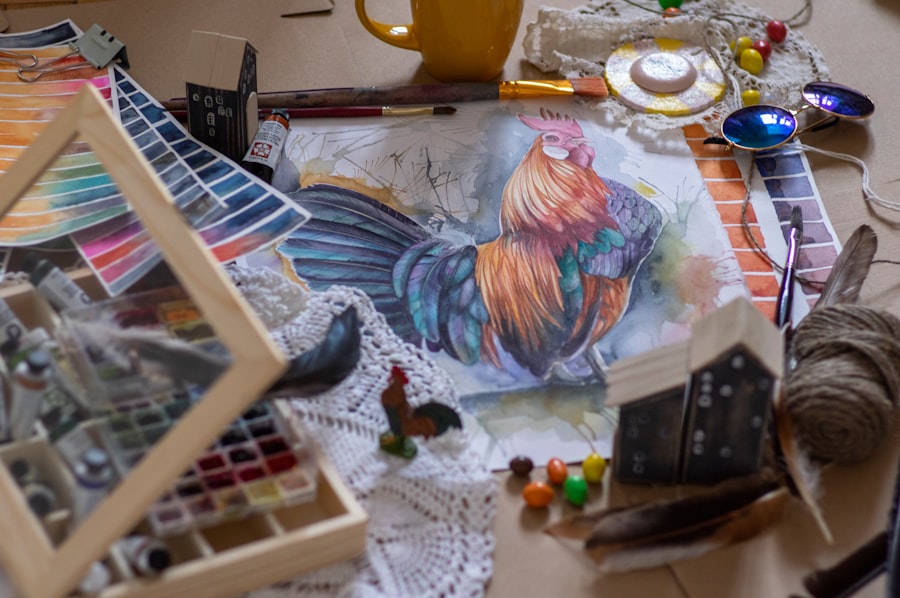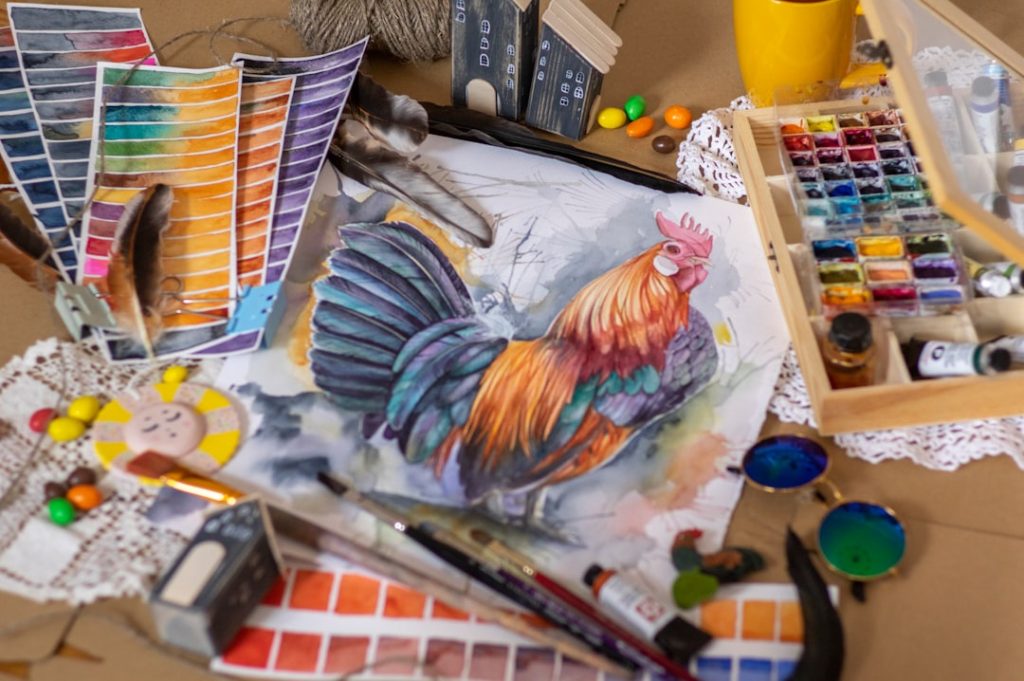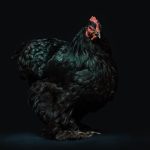Breed images play a crucial role in the poultry industry as they serve as a visual representation of various chicken breeds. These images are essential for breed identification, breeding and genetics, and showcasing unique characteristics in poultry shows and exhibitions. They help poultry enthusiasts and farmers make informed decisions about which breeds to raise based on specific needs and preferences.
Breed images also contribute to the preservation and promotion of rare and heritage breeds by providing a platform for recognition and appreciation by a wider audience. Breed images serve as a valuable educational tool for both novice and experienced poultry keepers. They provide a clear visual reference for understanding physical attributes, color patterns, and other distinguishing features of different chicken breeds.
This is particularly important for breeders and exhibitors who need to accurately identify and differentiate between breeds to maintain standards and ensure stock purity. Additionally, breed images promote breed diversity and conservation efforts by highlighting unique traits and characteristics, thus encouraging the preservation of genetic diversity within the poultry industry.
Table of Contents
- 1 Popular Breeds of Chickens and Their Characteristics
- 1.1 Chicken breeds are incredibly diverse, with each breed boasting its own unique characteristics and traits that make them suitable for different purposes. Whether you’re looking for egg production, meat quality, or ornamental value, there’s a breed out there for you.
- 1.2 Physical Characteristics
- 1.3 Importance of Breed-Specific Traits
- 2 How Breed Images Can Help in Identification
- 3 The Role of Breed Images in Poultry Shows and Exhibitions
- 4 Utilizing Breed Images for Breeding and Genetics
- 5 Where to Find High-Quality Breed Images
- 6 The Impact of Breed Images on the Poultry Industry
- 7 FAQs
- 7.1 What are the different breeds of chickens?
- 7.2 What are the differences between the breeds of chickens?
- 7.3 Where can I find images of different breeds of chickens?
- 7.4 Are there any resources for identifying different breeds of chickens?
- 7.5 Can I use images of chicken breeds for educational or commercial purposes?
Key Takeaways
- Breed images are important for identifying and understanding different chicken breeds
- Popular chicken breeds have distinct characteristics that can be identified through breed images
- Breed images are essential for accurate identification and classification in the poultry industry
- Poultry shows and exhibitions rely on breed images to showcase and judge different chicken breeds
- Breed images are valuable for breeding and genetics to maintain and improve desirable traits in chicken breeds
- High-quality breed images can be found in poultry breed standards, online databases, and breed association websites
- Breed images play a significant role in promoting and marketing different chicken breeds in the poultry industry
Popular Breeds of Chickens and Their Characteristics
Chicken breeds are incredibly diverse, with each breed boasting its own unique characteristics and traits that make them suitable for different purposes. Whether you’re looking for egg production, meat quality, or ornamental value, there’s a breed out there for you.
Popular Breeds
Some popular breeds include the Rhode Island Red, known for its excellent egg-laying abilities and hardiness; the Leghorn, prized for its prolific egg production and active nature; the Plymouth Rock, valued for its dual-purpose qualities as both a good egg layer and meat bird; and the Orpington, recognized for its gentle temperament and large size. Other popular breeds include the Sussex, Wyandotte, Australorp, and Brahma, each with its own unique set of attributes that make them desirable for various poultry keeping endeavors.
Physical Characteristics
Each breed has specific physical characteristics that distinguish them from one another. For example, the Leghorn is known for its white feathers, single comb, and slender build, while the Orpington is characterized by its fluffy appearance, gentle disposition, and variety of feather colors including black, blue, buff, and white.
Importance of Breed-Specific Traits
Understanding these breed-specific traits is essential for poultry keepers to make informed decisions about which breeds to raise based on their intended purpose, climate, available space, and personal preferences. By recognizing the unique characteristics of each breed, poultry keepers can choose the breeds that best fit their needs and goals.
How Breed Images Can Help in Identification

Breed images are invaluable tools for breed identification as they provide a visual reference for distinguishing between different chicken breeds. By studying breed images, poultry enthusiasts can familiarize themselves with the unique physical characteristics and color patterns of each breed, making it easier to identify them accurately. This is particularly important for breeders, exhibitors, and judges who need to be able to recognize and differentiate between various breeds to maintain breed standards and ensure the purity of their stock.
Breed images also help in preventing crossbreeding and maintaining breed purity by allowing poultry keepers to visually compare their birds with standard breed images to ensure that they meet the desired breed characteristics. This is essential for preserving the genetic integrity of purebred chickens and preventing the dilution of desirable traits through accidental or intentional crossbreeding. Additionally, breed images serve as a reference for poultry keepers to assess the quality of their birds and make informed decisions about which individuals to select for breeding purposes based on their adherence to breed standards.
The Role of Breed Images in Poultry Shows and Exhibitions
Breed images play a crucial role in poultry shows and exhibitions as they serve as a visual representation of the ideal breed standard for each chicken variety. These images are used by judges to evaluate the conformation, coloration, and overall quality of exhibited birds against the established breed standards. Breed images provide a reference point for exhibitors to understand the desired traits and characteristics that judges will be looking for when assessing their birds, thus helping them to prepare and present their birds effectively.
In addition to aiding judges in their evaluation process, breed images also contribute to educating the public about the diversity of chicken breeds and promoting an appreciation for the unique qualities of each breed. By showcasing high-quality breed images alongside exhibited birds, poultry shows and exhibitions provide an opportunity for attendees to learn about different breeds, their history, uses, and distinctive features. This not only helps in raising awareness about rare and heritage breeds but also encourages the preservation of genetic diversity within the poultry industry.
Utilizing Breed Images for Breeding and Genetics
Breed images are essential for breeding and genetics as they provide a visual reference for selecting breeding stock based on desired traits and characteristics. Poultry keepers can use breed images to compare individual birds with standard breed representations to identify those that best conform to the ideal breed standard. This is crucial for maintaining breed purity and improving specific traits such as egg production, meat quality, or ornamental features through selective breeding practices.
Furthermore, breed images aid in documenting and preserving genetic diversity within chicken breeds by providing a visual record of breed standards and variations over time. This is particularly important for rare and heritage breeds that are at risk of genetic erosion due to declining population numbers. By utilizing breed images as a reference point, poultry breeders can work towards conserving genetic diversity within these breeds by selecting breeding stock that represents the full range of genetic variation present within the population.
Where to Find High-Quality Breed Images

Finding High-Quality Breed Images
Reputable Sources for Breed Images
High-quality breed images can be found in a variety of sources, including reputable poultry breed associations, online databases, books on poultry breeds, and websites dedicated to poultry keeping and breeding.
Poultry Breed Associations: A Valuable Resource
Poultry breed associations, such as the American Poultry Association (APA) and the American Bantam Association (ABA), often provide official standards of perfection that include detailed descriptions and illustrations of each recognized breed. These standards serve as a valuable resource for obtaining accurate breed images that reflect the ideal conformation, coloration, and other physical attributes of each breed.
Online Resources and Books on Poultry Breeds
Online databases and websites dedicated to poultry breeds offer a wealth of information and high-quality images that can be used for reference purposes when identifying or selecting chicken breeds. These resources often include photographs, illustrations, and detailed descriptions of various breeds along with historical background information, breed characteristics, and practical advice on raising and breeding specific breeds. Additionally, books on poultry breeds written by experienced poultry keepers and breeders are another valuable source of high-quality breed images that provide comprehensive coverage of different chicken varieties along with practical insights into their care, management, and breeding.
The Impact of Breed Images on the Poultry Industry
The impact of breed images on the poultry industry is far-reaching as they contribute to breed identification, preservation of genetic diversity, education, promotion of rare breeds, and improvement of breeding practices. By providing a visual reference for distinguishing between different chicken breeds, breed images help in maintaining breed purity, preventing crossbreeding, and preserving genetic integrity within purebred chicken populations. This is essential for upholding breed standards and ensuring that desirable traits are passed on through selective breeding practices.
Furthermore, breed images play a key role in promoting an appreciation for the diversity of chicken breeds and raising awareness about rare and heritage breeds that are at risk of extinction. By showcasing high-quality breed images in poultry shows, exhibitions, educational materials, and online resources, the poultry industry can help in preserving genetic diversity within chicken breeds by encouraging the conservation and responsible stewardship of rare breeds. Additionally, breed images serve as a valuable educational tool for novice poultry keepers by providing a visual reference for understanding different breeds’ unique characteristics and traits.
In conclusion, breed images are essential for understanding the importance of different chicken breeds in the poultry industry. They serve as a visual representation of each breed’s unique characteristics and traits that make them suitable for various purposes such as egg production, meat quality, or ornamental value. Breed images play a crucial role in breed identification, preservation of genetic diversity, education, promotion of rare breeds, improvement of breeding practices, and raising awareness about the diversity of chicken breeds within the poultry industry.
By utilizing high-quality breed images from reputable sources such as poultry associations, online databases, books on poultry breeds, and dedicated websites, poultry enthusiasts can gain valuable insights into different chicken varieties’ physical attributes and select breeding stock based on desired traits to maintain breed purity and improve specific characteristics through selective breeding practices.
If you’re interested in learning more about keeping chickens, you might want to check out this article on how many chickens you need for a family of 4. It provides valuable information on the number of chickens required to meet the egg and meat needs of a typical family.
FAQs
What are the different breeds of chickens?
There are hundreds of different breeds of chickens, each with its own unique characteristics and traits. Some popular breeds include the Rhode Island Red, Leghorn, Plymouth Rock, and Wyandotte.
What are the differences between the breeds of chickens?
The differences between chicken breeds can include size, color, egg production, temperament, and purpose (meat, eggs, or ornamental).
Where can I find images of different breeds of chickens?
You can find images of different breeds of chickens on websites dedicated to poultry, agricultural publications, and breed-specific organizations. Additionally, many breeders and hatcheries have websites with images of the chickens they offer.
Are there any resources for identifying different breeds of chickens?
Yes, there are many resources available for identifying different breeds of chickens, including books, online guides, and breed-specific organizations. These resources often include images and descriptions of each breed’s characteristics.
Can I use images of chicken breeds for educational or commercial purposes?
The use of images of chicken breeds for educational or commercial purposes may require permission from the copyright holder. It is important to respect copyright laws and obtain the necessary permissions before using any images for these purposes.

Meet Walter, the feathered-friend fanatic of Florida! Nestled in the sunshine state, Walter struts through life with his feathered companions, clucking his way to happiness. With a coop that’s fancier than a five-star hotel, he’s the Don Juan of the chicken world. When he’s not teaching his hens to do the cha-cha, you’ll find him in a heated debate with his prized rooster, Sir Clucks-a-Lot. Walter’s poultry passion is no yolk; he’s the sunny-side-up guy you never knew you needed in your flock of friends!


Reputable Sources for Breed Images
High-quality breed images can be found in a variety of sources, including reputable poultry breed associations, online databases, books on poultry breeds, and websites dedicated to poultry keeping and breeding.
Poultry Breed Associations: A Valuable Resource
Poultry breed associations, such as the American Poultry Association (APA) and the American Bantam Association (ABA), often provide official standards of perfection that include detailed descriptions and illustrations of each recognized breed. These standards serve as a valuable resource for obtaining accurate breed images that reflect the ideal conformation, coloration, and other physical attributes of each breed.
Online Resources and Books on Poultry Breeds
Online databases and websites dedicated to poultry breeds offer a wealth of information and high-quality images that can be used for reference purposes when identifying or selecting chicken breeds. These resources often include photographs, illustrations, and detailed descriptions of various breeds along with historical background information, breed characteristics, and practical advice on raising and breeding specific breeds. Additionally, books on poultry breeds written by experienced poultry keepers and breeders are another valuable source of high-quality breed images that provide comprehensive coverage of different chicken varieties along with practical insights into their care, management, and breeding.
The Impact of Breed Images on the Poultry Industry
The impact of breed images on the poultry industry is far-reaching as they contribute to breed identification, preservation of genetic diversity, education, promotion of rare breeds, and improvement of breeding practices. By providing a visual reference for distinguishing between different chicken breeds, breed images help in maintaining breed purity, preventing crossbreeding, and preserving genetic integrity within purebred chicken populations. This is essential for upholding breed standards and ensuring that desirable traits are passed on through selective breeding practices.
Furthermore, breed images play a key role in promoting an appreciation for the diversity of chicken breeds and raising awareness about rare and heritage breeds that are at risk of extinction. By showcasing high-quality breed images in poultry shows, exhibitions, educational materials, and online resources, the poultry industry can help in preserving genetic diversity within chicken breeds by encouraging the conservation and responsible stewardship of rare breeds. Additionally, breed images serve as a valuable educational tool for novice poultry keepers by providing a visual reference for understanding different breeds’ unique characteristics and traits.
In conclusion, breed images are essential for understanding the importance of different chicken breeds in the poultry industry. They serve as a visual representation of each breed’s unique characteristics and traits that make them suitable for various purposes such as egg production, meat quality, or ornamental value. Breed images play a crucial role in breed identification, preservation of genetic diversity, education, promotion of rare breeds, improvement of breeding practices, and raising awareness about the diversity of chicken breeds within the poultry industry.
By utilizing high-quality breed images from reputable sources such as poultry associations, online databases, books on poultry breeds, and dedicated websites, poultry enthusiasts can gain valuable insights into different chicken varieties’ physical attributes and select breeding stock based on desired traits to maintain breed purity and improve specific characteristics through selective breeding practices.
If you’re interested in learning more about keeping chickens, you might want to check out this article on how many chickens you need for a family of 4. It provides valuable information on the number of chickens required to meet the egg and meat needs of a typical family.
FAQs
What are the different breeds of chickens?
There are hundreds of different breeds of chickens, each with its own unique characteristics and traits. Some popular breeds include the Rhode Island Red, Leghorn, Plymouth Rock, and Wyandotte.
What are the differences between the breeds of chickens?
The differences between chicken breeds can include size, color, egg production, temperament, and purpose (meat, eggs, or ornamental).
Where can I find images of different breeds of chickens?
You can find images of different breeds of chickens on websites dedicated to poultry, agricultural publications, and breed-specific organizations. Additionally, many breeders and hatcheries have websites with images of the chickens they offer.
Are there any resources for identifying different breeds of chickens?
Yes, there are many resources available for identifying different breeds of chickens, including books, online guides, and breed-specific organizations. These resources often include images and descriptions of each breed’s characteristics.
Can I use images of chicken breeds for educational or commercial purposes?
The use of images of chicken breeds for educational or commercial purposes may require permission from the copyright holder. It is important to respect copyright laws and obtain the necessary permissions before using any images for these purposes.
Meet Walter, the feathered-friend fanatic of Florida! Nestled in the sunshine state, Walter struts through life with his feathered companions, clucking his way to happiness. With a coop that’s fancier than a five-star hotel, he’s the Don Juan of the chicken world. When he’s not teaching his hens to do the cha-cha, you’ll find him in a heated debate with his prized rooster, Sir Clucks-a-Lot. Walter’s poultry passion is no yolk; he’s the sunny-side-up guy you never knew you needed in your flock of friends!







